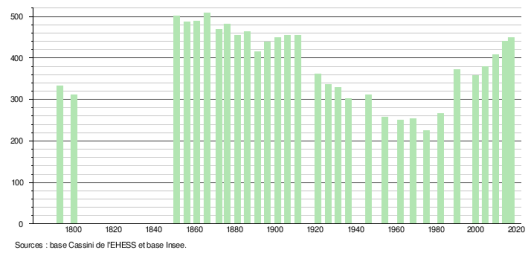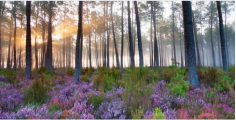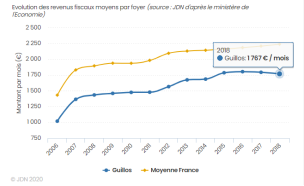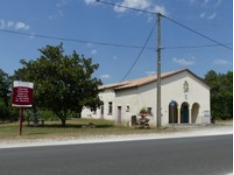Guillos, Gironde, Nouvelle-Aquitaine 作者: 来源: 发布时间:2021-09-23
I.Population and Area
Total Area: 22.67 km2
Population in 2017: 450
Population Density: 20 /km2
Histogram of demographic change

Sources : https://fr.wikipedia.org/wiki/Guillos#D%C3%A9mographie
II.Natural Geography (environment and resources)

Guillos is a town in southwestern France, located in the Gironde department, in the Nouvelle-Aquitaine region.
Municipality of the urban area of Bordeaux, located on the Tursan, tributary of the Ciron, the town is located 38 km south of Bordeaux, capital of the department, 23 km west of Langon, capital of district and 18 km south-west of Podensac, capital of the canton.
The neighboring municipalities are Landiras to the east, Origne to the south, Louchats to the south-west and Cabanac-et-Villagrains to the north-west.
Communication routes and transport:
The main roads are the D 120 departmental road which leads north to Cabanac-et-Villagrains then La Brède and south to Origne and Saint-Symphorien, the D 125 departmental road which leads north-east to Landiras then Cadillac or Langon and the D 115 departmental road which leads south-west to Hostens.
The nearest access to the A62 (Bordeaux-Toulouse) motorway is number 2, known as Podensac, which is 15 km to the north-east.
Access no.1, known as de Bazas, to the A65 motorway (Langon-Pau) is located 30 km east-south-east.
The closest SNCF stations are those of Barsac, Cévrier and Podensac, all three 18 or 19 km from the village. That of Langon, which offers more traffic, is 23 km away. In these four stations, the network is that of the Bordeaux - Sète line of the TER Nouvelle-Aquitaine.
III.ECONOMY
Employment rate (%): 79 (2017)
Average employment income (€):1 767 net per month (21 204net per year)(2018)

Evolution of average monthly net wages
Sources : http://www.journaldunet.com/business/salaire/guillos/ville-33197
https://insee.fr/fr/statistiques/2011101?geo=COM-33197#chiffre-cle-5
IV.Industrial Characterisitics
Sectors of activity most represented in Guillos
The table below lists the five sectors of activity with the most companies in Guillos during the period from 24/09/2019 to 24/09/2020 as well as the share of each sector on the total number of 'enterprises of the municipality.
Sector of activity | Number of companies | Share of companies |
Silviculture and other forestry activities | 14 | 21.2% |
Rental and operation of own or leased real estate | 9 | 13.6% |
Permanent crops | 3 | 4.5% |
Retail trade on stalls and markets | 3 | 4.5% |
Other passenger land transport | 3 | 4.5% |
Place of production of gravel (AOC).
Mrs Marie-Hélène DUPOUY-GUIGNARD
26 Guillemin North 33720 Guillos
Phone: 05 56 62 50 96
Originally, the appellation of "Graves" wines was approved in 1959.
We are in Graves country, and the property is called the Domaine du Cap de Haut, at a place called "Guillemin", on the road to Cabanac.
Located in the GRAVES region, the wine property covers an area of 9.5 ha and is divided into production of red wine (5 ha) and white (4.5 ha). There is an annex site, in the town of Landiras (place called Menon), with an area of 2.5 ha, devoted to the production of white wine. The family vineyard has been passed down from generation to generation, for almost 100 years. It is the only and last wine producer in the town. However, some winegrower owners continue to cultivate their vines, to produce a red wine for personal consumption.
The harvested wine has a beautiful color, a fragrant bouquet, body, finesse, and is distinguished from Médoc wines, by a very personal taste like all the other "Graves" red Wine classified A.O.C. Graves.
Direct sale of wine in retail and in bulk, from producer to consumer, at the property.
Marie-Hélène DUPOUY-GUIGNARD is the daughter of our former Mayor, Roland DUPOUY, who held office from 1983 to 1995. She is the granddaughter of Raphaël DUPOUY, who was Mayor of the town from 1965 to 1979, and father of Roland DUPOUY.
Marie-Hélène worked for several years alongside the former secretary of Town Hall Monique COURBIN, at the Town Hall of Guillos.
She was, moreover, Municipal Councilor, in the former team of the Town Hall under the mandate of Jean-Louis BEDOUT, from 1995 to 2014.
Winemaker, she is also with her husband (F.Guignard), winegrower at Château de ROLLAND (Guignard François, Lucie and Monique family), winegrowers in Barsac.
The sweet white wines of Château de ROLLAND have the 2 AOCs: BARSAC and SAUTERNES.
Possibility of a complete guided tour of 1.5 hours with tasting. Lucie will explain to you the culture of the vineyard, the wine, the history of the Château and the dovecote ... Family property since 1971, on 20 ha of vines in one piece crossed by the old Cours du Ciron (old stone bridge) and dominated by its 15th century dovecote. Tasting of four wines in the barrel cellar. Best of Wine 2016 in the “Architecture and Landscape” category. INDIVIDUAL VISIT: Free GROUP VISIT: Free (Group up to 50 people)
ROLLAND CASTLE
GUIGNARD 3 family, Château de Rolland BARSAC
05 56 27 15 02
info@chateauderolland.com www.chateauderolland.com
No alcoholic beverages may be sold or offered to minors
under the age of 18 (article L3348-1 of the public health code)
Alcohol abuse is dangerous for your health, consume in moderation
Sources: http://entreprises.lefigaro.fr/guillos/ville-33197
V.Attractions
1.Saint-Martin church

The Saint-Martin church was built in 1862 in the neo-Roman style on the site of an old church; it is surmounted by a Donnet bell tower.
It houses a statue of the Virgin and Child which dates from the 15th century and which was classified in the inventory of historical monuments in 1903.
In the 12th century, the parish church of Guillos, Romanesque, was too small to accommodate all its faithful inhabitants. It was a place of passage, of prayer and of rest for the "Jacquets" of Compostela coming from the neighboring village, Saint-Michel-de-Rieufret.
It should be noted that another Romanesque church, now demolished, was located in the village of the village, at the level of the "chemin de la Cure", on a registered plot n ° 1564, section B, which has become a vine plantation, ( belonging to a Guillossian owner). On the plot there was the old communal cemetery. There is no vestige of this church today, and on the ground there are still stones, testimony of its construction.
Another historical evidence that supports the arguments that this church existed (date?): A local farmer accidentally discovered a wooden statue of Madonna and Child while he was plowing his field. Due to lack of old documents or archives, we do not know the time of construction of this church ... It is precisely this same statue which is in the current church, which in the village of the village, is located about 200 m from this missing church.
The current church of Guillos, placed under the name of Saint Martin, was rebuilt in the 19th century on the remains of a Romanesque building. Our church is dedicated to Saint-Martin, the patron saint of travelers.
There are very few traces of the early church, which has been very popular with pilgrims to Santiago de Compostela since the Middle Ages. In 1862, it was decided to rebuild it in a neo-Romanesque style. The work is being carried out by the contractor Pierre GASTON, under the direction of the Bordeaux architect, Pierre-Paul COURAU.
The Saint-Martin church is built on a classic Latin cross plan, with a single nave with barrel vaulting. The apse has a cul-de-four vaulted ceiling. A steeple porch topped with an arrow rises to the west, it presents a portal of great simplicity.
The cul-de-four apse is in the shape of a quarter-sphere, used from antiquity until the end of the Romanesque period to cover the apses of Latin churches. It is generally oriented towards the east.
On the opposite side, that is to the west of the building, we find the porch and its stone portal.
On April 22, 1950, Pope PIE XII dedicated this Saint-Martin church to the Blessed Virgin Mary, Virgin of Hope, as evidenced by the text engraved above the door of the sacristy.
2.The party room

The Salle des Fêtes is located opposite the Town Hall, Route de Landiras.
Our Communal Hall, which dates from the 20th century, has a concrete and brick frame. It was equipped with a sound system in June 2010, following the wishes of the Mayor of the town and his Municipal Council. It is the Primary School of Guillos, during its annual Kermesse, which inaugurated it, in a way, and to the greatest satisfaction of a delighted audience (many parents of students.
Sources :https://www.patrimoine-religieux.fr/eglises_edifices/33-Gironde/33197-Guillos/173178-EgliseSaint-MartinNotre-DamedEsperance
http://www.guillos.fr/z/site.php?act=1_3
VI.History
For the situation of the town in the 18th century, see the work by Jacques BAUREIN. (BORDELOISES varieties = 6 volumes)
During the Revolution (WIKIPEDIA), 1789, the parish of Saint-Martin de Guillos formed the municipality of Guillos. In the year IX (1800-1801), the municipality of Guillos is attached to that of Landiras which becomes Landiras-et-Guillos. In 1850, the municipality of Landiras was reestablished by dismembering that of Landiras-et-Guillos. The municipality of Guillos then becomes independent.
In the 10th century, Bordeaux and its region came under the domination of the Dukes of Aquitaine. The daughter of the last duke, Aliénor d'Aquitaine, frivolous wife, then separated from the king of France Louis VII (August 1, 1137 saw the marriage in Bordeaux of Aliénor d'Aquitaine with Louis VII, king of France, in the cathedral of Saint -André), remarried to Henri Plantagenêt, in 1152, (who became king of England two years later), and brought Aquitaine to the crown of England.
The medieval period was marked by English domination in Aquitaine for three centuries (from the 12th to the 15th century) and the great pilgrimages to Saint-Jacques de Compostelle.
For three centuries, Aquitaine was thus linked to the fate of the kingdom of England. In 1204, Philippe-Auguste recaptured Aquitaine from the English except Guyenne. In 1303, the Hundred Years War began, which pitted the French against the English. The people of Aquitaine have often preferred the English to the French. Raids are undertaken against the French by the English and Aquitaine.
The parish of Guillos is held, in the XIVth century, by Gaillard de SAINT-SYMPHORIEN who is the lord high justice. This family is the oldest known as Lords of Guillos. It reports initially to the royal provost of Barsac, then it becomes a dismemberment. It is attached to the seigneury of Landiras, which from MONTFERRAND passes to BRASSIER, then to BUDOS. When the municipalities were created after the Revolution, Guillos was part of Landiras. It was detached from it in 1850 and became a fully-fledged municipality.
It was in 1850 that the municipality of Guillos elected its first Mayor Jean DULOU.
Guillos then belonged to the Lordship of Landiras. Later the Lordship of Landiras was attached to the Royal Provost of Barsac. Then in 1453, the English army was defeated at Castillon-la-Bataille. A battle
won by the Count of DUNOIS. This episode marked the end of the English occupation, the end of the Hundred Years War (1448-1453). France definitively reconquers Aquitaine.
By this time the English had lost the land they owned in France. They had part of Aquitaine with Bordeaux. The English king Henry VI had commissioned old General Talbot to take back the lost lands. The King of France was to destroy this last English army which was still in his country. The French army had settled on favorable ground surrounded by a river near Castillon. General Talbot, from Bordeaux, attacks without waiting for his entire army. The French army had 10,000 men with archers, horsemen and 300 cannons. There were also 1000 Breton soldiers. It was commanded by King Charles VII. The English army with Aquitaine soldiers had 6,000 men.
The French artillery of the Bureau brothers destroys the English army. There were 6,000 dead and many prisoners. Talbot and his son will be killed. Castillon last battle of the Hundred Years War is a French victory.
Castillon-la-Bataille evokes the decisive fight which took place in July 1453 in the plain of Colly, and which saw the English and the French clash. General Talbot was killed by Charles VII's troops, led by the Bureau brothers, and his army of 8,000 was decimated. The defeat of the English put an end to the Hundred Years War, and was at the origin of the attachment of Aquitaine to the kingdom of France.
The end of the Anglo-Gascon union occurs on July 17, 1453. The king of France CHARLES VII inflicts defeat after defeat on the English in the North and in Normandy, before taking an interest in the South-West. Charles VII, although victorious once again, was not long in being challenged by the Bordelais. Indeed, the latter lived off their wine exports to England, and the French victory was not helping their affairs. In addition, the new taxes imposed by Charles VII in order to maintain the French garrisons were very poorly accepted.
But, in revolt against the lifting of a tax intended to pay the French garrisons, Bordeaux recalls its allies. John TALBOT, a 70 year old warrior, landed at the head of 10,000 men and liberated Bordeaux in October 1452. In July 1453, the French army took refuge near Castillon. Too sure of himself, Talbot decides to lead the assault without waiting for the arrival of his guns. The French artillery inflicts heavy losses on the attackers. Talbot, his wounded horse, is thrown to the ground and dies riddled with arrows. It is the British rout, 4,000 dead litter the ground. After a final resistance, Archbishop PEY BERLAND negotiates the Bordeaux surrender. October 19 is the end of independence. The English, faced with serious internal problems, definitively renounce Guyenne.
Charles VII decided to punish the Bordelais, suppressing their communal privileges, suspending the city's parliament, and demanding a war indemnity of 100,000 ecus. In addition, the Bordelais having collaborated the most with the English were driven out of the city. This is how the Hundred Years War ended, after more than 115 years of bloody strife. Henry VI, falling into madness as his maternal grandfather Charles VI had done, dragged England into a violent civil war. However, if today we consider that the Hundred Years War ended in 1453, no treaty officially ended it. Indeed, the English still held Calais, and by this date had not yet lost all hope of ever regaining a foothold in France.
The Battle of Formigny is a battle of the Hundred Years' War that took place on April 15, 1450 in Formigny near Bayeux, Normandy, between the English, the French and the Bretons. It ended in a decisive victory for the kingdom of France.
Castillon-la-Bataille fell into the hands of the French on July 20, 1453, Bordeaux in October, Aquitaine returned in "obedience to the King of France". The French victories of Formigny (1450) and Castillon (1453) put an end to this Hundred Years War. Bordeaux and the Duchy of Aquitaine become French again.
In 1953 Castillon, for the 500th anniversary of the battle of 1453, took the name of "Castillon la Bataille".
In 1850, under the II REPUBLIC (1848-1852), Guillos broke away from the town of Landiras and became autonomous ...
Sources: http://www.guillos.fr/z/site.php?act=1_2
VII.Other information
Forest:
A little history.
PIN (Maritime pine = Pinus pinaster Soland. Or Pinus maritima Lamb.). Also called Landes pine, Bordeaux pine, Maine pine. The largely majority species of our forests in the Landes and Gironde, this maritime pine,
this Landes Pine, this "golden tree", has reigned supreme since the Second Empire and even beyond that, in our ancestral Gascony ...
The Pine dates from the Jurassic period. The Latin name Pinus relates to an Indo-European root PIC ... which means
bitter, pix the pitch is attached to it, peuké, pitos in Greek, pine in English means pine and in Sanskrit we have pitu
= resin, cold, snot, pituite. The pine, a resinous tree par excellence, has in turn given
pinnace and barge, pinewood boats, typical throughout the Arcachon Bay.
The Maritime Pine, which grows in the wild, all over the Mediterranean coast, as far as Greece, is content
poor soil, but requires light and a minimum of heat. Originally from the southwest, it has also been introduced in Brittany, Sologne, Maine, and as far as the Paris Basin, where it can however freeze, during severe winters. It is also found in Spain, Portugal, Italy and even in North Africa. It is an essence of siliceous soil, of a very marked calcifuge character. In the southwest of France, it was planted from the 18th century.
In Antiquity, then in the Middle Ages, the Landes region was a vast unsanitary swamp, a dreaded stopover for the Pilgrims of Compostela. His lands were poor, lonely, wild and rather arid, barren and unhealthy. They hardly accommodated a rare population of shepherds, undermined by malaria. Under the threat of invading sand and polluted water, men sought from the 18th century to stop the advance of the dunes pushed by the wind.
It was under the Second Empire and Napoleon III that in 1857, an intensive and daring sanitation and afforestation program was launched in this region and which gave birth to the largest (artificial) forest in Europe (1 million d 'hectares). This newly created Landes forest has radically changed the region's climate, by stabilizing the sandy areas, but above all by drying up the wet and marshy lands, which has made it possible to reduce and disappear diseases such as malaria.
Influenced by the economist and philosopher Saint-Simon, by the law of 1857, Napoleon III had the idea of rehabilitating these deprived, miserable Landes, with poor, marshy lands. Hence the considerable change in these Landes lands, which extended to the Gironde and neighboring departments ... For for a long time, the Landes of Gascony was one of the most deprived regions of France. The region is rather flat, formed of a siliceous earth, rich in iron oxide which agglutinates in depth to form an impermeable layer, "alios".
Botanically speaking, according to the classification of the famous Swedish botanist and naturalist Carl Von LINNÉ (1707-1778).
The Pine belongs to the great Family of ABIETACEAE or PINACEAE, and to the sub-branch of GYMNOSPERMS (branch of PHANÉROGAMES), scientific name, more familiar under the vernacular name of CONIFERS or RESINOUS. Gymnosperms are around 300 million years old.
The Pine was introduced in France by agronomists and engineers of Water and Forests, at the end of the XVIIIth and the beginning of the XIXth century, first by BREMONTIER (1738-1809), who from 1788, fixed the dunes by seedlings of gourbet (or oyat) and by pine plantations; it is CHAMBRELENT (1817-1893), which thanks to the tests carried out in its property of Saint-Alban, in Pierroton, establishes a plan of drainage and seeding of the pines; it is finally the abbot Matthieu DESBIEY (1734-1787) and his brother Guillaume DESBIEY natives of Saint-Julien-en Born (40) established in La Teste-de-Buch, who in 1776, in a memoir read in front of the Academy of Sciences, Belles Lettres and Arts de Bordeaux, recommended the fixation of the sands by the plantation of pines.
Louis XVIII in 1818 wanted, by means of a monument erected in La Teste, on the edge of the road which leads to Pyla and Moulleau, to mark the recognition of the country in BREMONTIER, on a monument containing an inscription. All three had become, at the time, "environmentalists", and protectors and friends of nature, a term little known at the time.
The term "ecology" (all, Ökologie, from the Greek oikos, house and logos, science) appeared for the first time and was coined by the German biologist Ernst Haeckel. But this discipline, this science, "ecologism" took no
importance only from the 1930s.
Sources: http://www.guillos.fr/z/site.php?act=1_5
VIII.Contact information
Guillos town hall address :
Guillos Town Hall
14 Landiras road
33720 Guillos
Monday: from 2:00 p.m. to 5:30 p.m.
Mayor : Sylvia-Mylène Doreau (Mandate : 2014-2020)
Mail: mairie.guillos@orange.fr
Phone number: 05 56 62 52 08
Fax: 05 56 62 43 76
Website : http://www.guillos.fr
Sources : http://www.cartesfrance.fr/carte-france-ville/33197_Guillos.html
